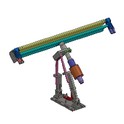Ultrasonic assisted machining (UAM) has emerged as a revolutionary technology in the manufacturing industry, offering significant advantages over traditional machining methods. As a leading supplier of ultrasonic assisted machining solutions, we have witnessed firsthand the transformative impact of UAM on material properties. In this blog post, we will explore the changes in material properties during ultrasonic assisted machining and how our products, such as the ResoTab-P20 Ultrasonic Vibration Tables, ResoTab-F20 Ultrasonic Vibration Tables, and ResoTab-P30 Ultrasonic Vibration Tables, contribute to these changes.


Understanding Ultrasonic Assisted Machining
Before delving into the changes in material properties, it is essential to understand the basic principles of ultrasonic assisted machining. UAM combines traditional machining processes, such as turning, milling, and grinding, with high-frequency ultrasonic vibrations. These vibrations are typically in the range of 20 kHz to 40 kHz and are applied to the cutting tool or the workpiece.
The ultrasonic vibrations introduce several beneficial effects during machining. Firstly, they reduce the cutting force required to remove material, resulting in lower power consumption and less wear on the cutting tool. Secondly, the vibrations help to break the chips into smaller pieces, improving chip evacuation and preventing chip clogging. Thirdly, the high-frequency vibrations can induce local heating and softening of the material, making it easier to cut.
Changes in Material Properties
The application of ultrasonic vibrations during machining can lead to significant changes in the material properties of the workpiece. These changes can be categorized into three main areas: mechanical properties, surface integrity, and microstructural changes.
Mechanical Properties
One of the most significant changes in mechanical properties during UAM is the improvement in surface hardness. The high-frequency vibrations can induce severe plastic deformation in the surface layer of the material, leading to grain refinement and work hardening. This results in an increase in surface hardness, which can enhance the wear resistance and fatigue life of the workpiece.
In addition to surface hardness, UAM can also improve the material's ductility and toughness. The ultrasonic vibrations can help to reduce the residual stress in the material, which can prevent crack initiation and propagation. This leads to an improvement in the material's ability to absorb energy and resist fracture.
Surface Integrity
Surface integrity refers to the quality of the surface layer of the workpiece, including its roughness, residual stress, and microstructure. UAM can significantly improve the surface integrity of the workpiece compared to traditional machining methods.
The ultrasonic vibrations can reduce the surface roughness of the workpiece by breaking the chips into smaller pieces and preventing them from adhering to the surface. This results in a smoother surface finish, which can improve the aesthetic appearance and functionality of the workpiece.
Furthermore, UAM can also reduce the residual stress in the surface layer of the material. The high-frequency vibrations can help to relieve the stress concentration in the material, which can prevent crack initiation and propagation. This leads to an improvement in the material's fatigue life and resistance to corrosion.
Microstructural Changes
The application of ultrasonic vibrations during machining can also induce microstructural changes in the material. The high-frequency vibrations can cause the grains in the material to rotate and reorient, leading to grain refinement. This can improve the material's mechanical properties, such as strength and hardness.
In addition to grain refinement, UAM can also induce phase transformations in the material. The high-frequency vibrations can cause the material to undergo a phase change from a metastable state to a more stable state, which can improve the material's properties.
Our Ultrasonic Assisted Machining Solutions
As a leading supplier of ultrasonic assisted machining solutions, we offer a range of products that are designed to enhance the performance of traditional machining processes. Our ResoTab-P20 Ultrasonic Vibration Tables, ResoTab-F20 Ultrasonic Vibration Tables, and ResoTab-P30 Ultrasonic Vibration Tables are specifically designed to provide high-frequency ultrasonic vibrations to the workpiece during machining.
These vibration tables are equipped with advanced ultrasonic transducers and control systems, which allow for precise control of the vibration amplitude and frequency. This ensures that the ultrasonic vibrations are applied effectively to the workpiece, resulting in optimal machining performance and improved material properties.
Conclusion
Ultrasonic assisted machining is a revolutionary technology that offers significant advantages over traditional machining methods. The application of high-frequency ultrasonic vibrations during machining can lead to significant changes in the material properties of the workpiece, including improvements in mechanical properties, surface integrity, and microstructural changes.
As a leading supplier of ultrasonic assisted machining solutions, we are committed to providing our customers with the highest quality products and services. Our ResoTab-P20 Ultrasonic Vibration Tables, ResoTab-F20 Ultrasonic Vibration Tables, and ResoTab-P30 Ultrasonic Vibration Tables are designed to enhance the performance of traditional machining processes and improve the material properties of the workpiece.
If you are interested in learning more about our ultrasonic assisted machining solutions or would like to discuss your specific machining requirements, please contact us. Our team of experts will be happy to assist you in finding the best solution for your needs.
References
- Tian, Y., & Lu, X. (2018). Ultrasonic-assisted machining: A review of the machining performance. International Journal of Machine Tools and Manufacture, 132, 47-68.
- Zhang, Y., & Zhu, D. (2019). A review on ultrasonic vibration-assisted machining in advanced materials. International Journal of Machine Tools and Manufacture, 141, 103427.
- Guo, Y., & Liu, Y. (2020). Ultrasonic-assisted machining of difficult-to-cut materials: A review. Journal of Manufacturing Processes, 53, 272-286.





